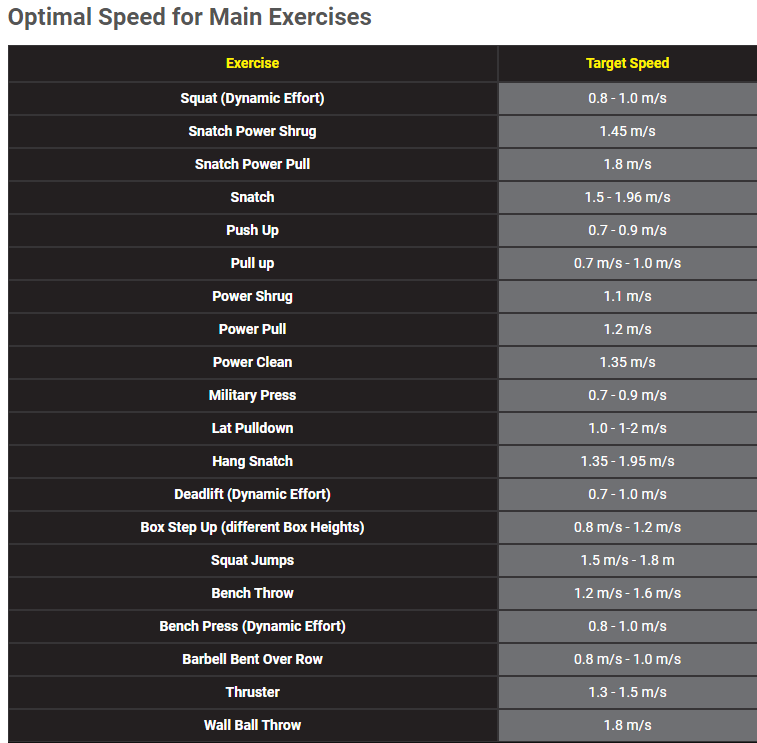Velocity Based Training for Olympic Weightlifting Movements
- Kristian McPhee

- Feb 7, 2020
- 7 min read
Updated: May 8, 2020

Velocity Based Training – Analysis & Practical Implementation for Weightlifting
Traditionally strength training programs have been based off one rep maximum (1RM) percentages in order to adapt the intensity and volume of the sessions to apply safe amounts of overload without causing injury and to account for residual fatigue. During training sessions coaches may reduce load if they can see slower movements or breakdowns in form. Percentage regulation and the coach’s eye can still leave large rooms of error because performance is multifactorial, such as sleep, mood, diet, the female monthly cycle and the individual’s response to training. By employing numerical feedback via the use of velocity sensors, it has become more possible than ever before to adapt training programs around bar speed. Velocity based training (VBT) will be analysed in relation to its applicability for coaches and athletes combined with the science behind in relation to weightlifting and its respective movements.
Due to new developments in easier and cheaper velocity measurement tools the field of VBT has been gaining rapid interest but it has by no means replaced traditional percentage-based programming due to a multitude of reasons. Using velocity measuring instruments during training a coach can measure the bar velocity during a lift. In practical terms if for example a 1RM squat reaches 0.15m/s then working for 3 repetitions between 0.20 m/s (anything below may increase risk of injury/fatigue or a failed lift) and 0.25 m/s (anything faster may be too light to induce enough overload) (Appleby et al., 2018; Hirsch et al., 2019; Pérez-Castilla et al., 2019).
If the athlete can obtain instant numerical feedback of their bar speed it may help them adjust their performance accordingly, especially in cases where the athlete may know their previous performances and wish to beat or match them. Hirsch et al. (2019) found that by using a target velocity during a barbell squat was more effective at improving their speed compared to telling the athletes to move faster. If a coach is able to make the lifter move faster then it is likely that the athlete will have an increased chance of completing a successful lift (such as having enough time to get under the bar during the clean) and therefore be able to lift more (Garhammer & Gregor, 1992). This would also allow coaches to estimate daily 1RM’s working off bar speed performance without having to have the athlete lift it (Hirsch et al., 2019).
A study from 2018 found that there were greater results from VBT feedback during a four week barbell squat jump study, where the group which received VBT feedback after every barbell jump performance increased their jump height performance the most compared to those who received VBT feedback 50% of the time or not at all. However the investigators note that reliance upon this type of feedback may create problems with performance where the velocity measurements are not available (Nagata et al., 2018). Therefore during a competition or if athletes train without the regular access to VBT measurements then it may have not have a significantly positive effect on performance in absence of VBT. In addition, Randell et al. (2011) found that whilst VBT helped improve certain movements, it did not improve all performance measurements across the whole range of tests (vertical jump, horizontal jump and sprint tests). Their results consequently show that the simple principles of training applied correctly (e.g. intensity, volume and trying to go as fast as possible) can still create improvements in athletes which are not significantly different than the VBT. However the athletes who did receive VBT did improve on average higher (but not statistically significantly) than those without, which may come down to that 1kg that elite weightlifters may be looking for (Randell et al., 2011).

Reliability as well as the price of the velocity measurement devices is a fundamental factor for coaches to consider when embarking on VBT for their athletes. Two studies have ranked a range of devices in order to accuracy (Mitter et al., 2019; Pérez-Castilla et al., 2019). The results showed that the two most practical, low cost and easy to use units (inertial measurements units) were also the least accurate (Push band and Beast Sensor). Showing that the practicality & affordability of VBT is still an issue, especially in Olympic Weightlifting where the barbell and athlete may not be going in a linear line (especially on recovery and when dropping or missing the lift) and can risk dropping the barbell onto the measurement unit such as the ground anchored Speed4lift unit. Research has also shown that a loaded barbell’s flexion during the movement may create bar speed inaccuracies and therefore the closer the sensor is to the centre of the barbell the more accurate the readings may be. It is therefore important that there is an accurate measurement of barbell displacement for VBT to be applied correctly (Appleby et al., 2018; Hirsch et al., 2019; Pérez-Castilla et al., 2019)
VBT therefore does not sit outside the usual limitations to cost and performance as the most accurate and the least risk of equipment damage during Olympic lifting would be the camera-based systems or linear velocity/position transducers that would be operated from a side angle to track movements, which are still very expensive systems, circa $3000 (ibid). The most accurate technology is still outside of the individual consumer’s affordability.
Applying VBT into traditional weightlifting programs also presents a challenge. Given that waiting sits towards the speeds-strength portion of the force-velocity curve, it would be apt for coaches to have greater knowledge of the bar velocity for accurately implementing volume and intensity for their athletes. Rate of force development (RFD) is an incredibly important aspect during the snatch, clean and jerk movements which require a large amount of force to be produced in a short amount of time in order to ‘throw’ the bar vertically to give the lifter time to get underneath it. In addition, it may also be useful for coaches wishing to load the respective exercises to their appropriate velocity in regard to their period of training, such as in early phases where they may be working more towards the strength-speed phase rather than speed-strength. However, the use of velocity measurements can ensure that the strength exercises such as pulls and squats are not so slow as to only be working towards maximal strength with little carry over to the sport. The RFD (and therefore peak bar velocity) as the lifter enters in the second pull (above the knee) and into the extension is most important measurement for VBT for weightlifters (Banyard et al., 2019; Garhammer & Gregor, 1992; Sakadjian et al., 2014).

Bar velocity measurement is recommended to be used for working sets during weightlifting training (and especially when there is the absence of a coach) in order to provide a form of athlete auto-regulation. The coach would stipulate minimum and maximum speeds to achieve for that day. In the case of 1-rep maxes it is less likely that VBT would be useful due to predictable lower bar speed due to its maximal load, unless it shows that there is a speed improvement for their 1RM, suggesting a new personal best is achievable.
Research on bar speeds has given a variation of peak bar speeds for the Olympic lifts because bar velocity must be higher for taller athletes to achieve success in the snatch and clean, which provides issues for coaching large numbers on arbitrary velocity numbers. During the snatch it is suggested that a peak bar speed optimal range is between 1.65 m/s – 2 m/s (depending on height) and for the clean 1.2m/s – 1.6m/s (depending on height) and 0.3m/s mean speed for squat variations (Harbili & Alptekin, 2014; Jidovtseff et al., 2011). Coaches must individualise bar velocity targets for this measurement to be applicable.

VBT is therefore an amazing tool for coaches to provide numerical data to assess the athlete’s condition rather than the traditional readiness questionnaire or vertical jump test. It would also be important and useful to record and monitor changes over time for athletes, such as increases, stagnations or slowing down of certain lifts in order to monitor progress or regression over micro and meso cycles, and monitoring fatigue in the build up to competitions. Further technological advancement, affordability and athlete profiling is suggested to further VBT’s applicability to its regular usage in the strength and conditioning world.
References
Appleby, B. B., Appleby, B. B., Banyard, H., Cormie, P., & Cormack, S. J. (2018). Validity and Reliability of Methods to Determine Barbell Displacement in Heavy Back Squats. Journal of Strength and Conditioning Research.
Banyard, H. G., Banyard, H. G., Tufano, J. J., Delgado, J., & Thompson, S. W. (2019). Comparison of the Effects of Velocity-Based Training Methods and Traditional 1RM-Percent-Based Training Prescription on Acute Kinetic and Kinematic Variables. International Journal of Sports Physiology and Performance, 14(2), 246–255.
Finadri, T. (2016) Optimal Speed Challenges for Your Lifts. (2016, December 31). Beast Blog. https://blog.thisisbeast.com/speed-targets/
Garhammer, J., & Gregor, R. (1992). Propulsion Forces as a Function of Intensity for Weightlifting and Vertical Jumping. Journal of Strength and Conditioning Research, 6(3), 129–134.
Harbili, E., & Alptekin, A. (2014). Comparative kinematic analysis of the snatch lifts in elite male adolescent weightlifters. Journal of Sports Science & Medicine, 13(2), 417.
Hirsch, S. M., Hirsch, S. M., & Frost, D. M. (2019). Considerations for Velocity-Based Training: The Instruction to Move “As Fast As Possible” Is Less Effective Than a Target Velocity. Journal of Strength and Conditioning Research.
Jidovtseff, B., Harris, N. K., Crielaard, J.-M., & Cronin, J. B. (2011). Using the load-velocity relationship for 1RM prediction. Journal of Strength and Conditioning Research, 25(1), 267–270.
Mitter, B., Hölbling, D., Bauer, P., & Stöckl, M. (2019). Concurrent Validity of Field-Based Diagnostic Technology Monitoring Movement Velocity in Powerlifting Exercises. Journal of Strength and Conditioning Research.
Nagata, A., Doma, K., Yamashita, D., & Hasegawa, H. (2018). The Effect of Augmented Feedback Type and Frequency on Velocity-Based Training-Induced Adaptation and Retention. Journal of Strength and Conditioning Research.
Pérez-Castilla, A., Piepoli, A., Delgado-García, G., & Garrido-Blanca, G. (2019). Reliability and Concurrent Validity of Seven Commercially Available Devices for the Assessment of Movement Velocity at Different Intensities During the Bench Press. Journal of Strength and Conditioning Research, 33(5), 1258–1265.
Randell, A. D., Cronin, J. B., Keogh, J. W. L., & Gill, N. D. (2011). Effect of instantaneous performance feedback during 6 weeks of velocity-based resistance training on sport-specific performance tests. Journal of Strength and Conditioning Research, 25(1).
Sakadjian, A., Panchuk, D., & Pearce, A. J. (2014). Kinematic and kinetic improvements associated with action observation facilitated learning of the power clean in Australian footballers. Journal of Strength and Conditioning Research, 28(6).





Comments